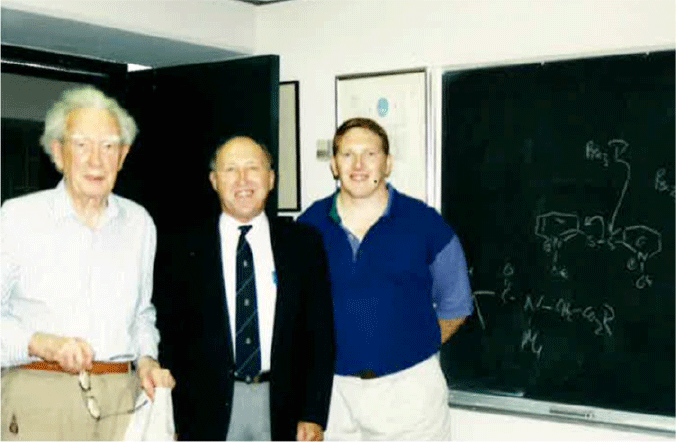Sir Derek Harold Richard Barton: The Australian Legacy
Jason A. SmithSchool of Natural Sciences – Chemistry, University of Tasmania, Hobart, Tas. 7001, Australia. Email: jason.smith@utas.edu.au

Jason Alfred Smith is a graduate of Flinders University in South Australia where he obtained both his B.Sc. (Hons) and Ph.D. degrees, the latter under the supervision of Professor Rolf Prager. He carried out post-doctoral research at Texas A&M University (with Professor Sir Derek H. R. Barton) and at The Australian National University (with Professor Martin G. Banwell). In 2001, he joined the faculty in the School of Chemistry at The University of Tasmania where his research activities focus on synthetic methodologies and their application to the synthesis of biologically active and/or structurally complex molecules and natural products isolation. |
Australian Journal of Chemistry 71(9) 625-626 https://doi.org/10.1071/CHv71n9_FO
Published: 25 September 2018
This special issue of the Australian Journal of Chemistry celebrates the centenary of the birth of Sir Derek Harold Richard Barton, undoubtedly one of the most influential organic chemists of the 20th century. Sir Derek was born on 8 September 1918 and obtained his Ph.D. from Imperial College in 1942. Throughout his career, Sir Derek worked in numerous and diverse areas, from his first paper on the isolation of ethyl quinone from flour beetles,[1] through to the seminal work on conformational analysis[2] (for which he shared the 1969 Chemistry Nobel Prize with Odd Hassel), the numerous radical reactions from Barton nitrite photolysis[3] to Barton ester decarboxylation,[4] and finally hydrocarbon oxidation using non-heme iron complexes referred to as Gif Chemistry.[5] Much of this work had significant impact in the field and in some instances changed our understanding of chemistry and how it was performed in the laboratory. There have been numerous reviews of Barton’s work and his approach to chemistry, including the books, Some Recollections and Gap Jumping[6] and Reason and Imagination,[7] in which Sir Derek himself describes what he considered his most important and original papers. He was a strong proponent for the ‘Invention of Chemical Reactions’. What this meant was that when faced with how to carry out an unknown transformation, one should develop a new reaction to perform it. The first example of this was the Barton nitrite photolysis reaction which enabled the synthesis of aldosterol acetate[8] and thus taking the world supply from milligrams to grams.[7] He continued with this strategy until the end of his career and left a lasting legacy to the chemistry community with his more than 1000 scientific papers. Perhaps less known is his indirect impact on the Australian chemistry community through the numerous Australians who spent time in the Barton laboratories, mostly at Imperial College in London, but also right up to the end of his career at Texas A&M University in College Station, USA. The stories of Sir Derek as a tyrant were common, but not always accurate. He worked hard and demanded that same commitment from everyone else, but he was also very supportive and generous. Right up until the end in the weekly group meetings, everyone would have their time at the blackboard to go through the previous week’s work, analyse the results, and plan for the next week. He was always ready to challenge anyone to propose a reaction mechanism and you had to be ready to propose a reasonable solution. Some relished the opportunity to impress the boss while others trembled with the thought of it each week and spent hours preparing. What was instilled into me at these meetings – and I’m sure into others as well – was how thorough you must be when you get a new result. You needed all the experimental evidence and you must have done all the ‘blank reactions’, although I could never work out why the blank reactions required leaving out either the reactant or the substrate. Perhaps the point was to emphasise how thorough you must be. During my own graduate studies with Professor Rolf Prager, also a post-doctoral fellow with Sir Derek at Imperial College, I remember taking in the proton and carbon NMR spectra and one of the first things he would say was ‘Where is the infrared?’ I soon realised where this had come from – Sir Derek. This was one of Sir Derek’s strengths, not just the chemistry he worked on, but how we went about it. He would always say if you know what the outcome of a reaction is going to be, then why do it? Much better to do something for which you do not know what the outcome will be and from that you will learn something. This also meant that when you had a new reaction you had to work quickly to get as many examples done; he was not keen on large tables of examples. Once you had an acyclic derivative, a cyclic derivative, and possibly an example with a steroid, that was enough, time to move on. And this, I believe, is the greatest legacy of Sir Derek for Australian organic chemistry – the way he approached and thought about chemistry was passed down to those who worked with him, including the many Australians who brought these principles back with them into academia and, therefore, continued to influence generations of chemists in Australia (Fig. 1).

|
In this special issue dedicated to Sir Derek, we see his influences in natural products and synthetic methods through the isolation and biomimetic synthesis of natural products, synthesis of biological active molecules, and the development of new methodology for the synthesis of heterocycles and peptides. It also contains reviews covering recent developments on the synthesis of steroids and photodecarboxylayion involving phthalimide derivatives. I hope you enjoy the chemistry in this issue and also reflect on the contributions of Sir Derek Barton as a celebration of a fantastic career that continues to influence the field.
References
[1] P. Alexander, D. H. R. Barton, Biochem. J. 1943, 37, 463.| Crossref | GoogleScholarGoogle Scholar |
[2] D. H. R. Barton, Experentia 1950, 6, 316.
| Crossref | GoogleScholarGoogle Scholar |
[3] D. H. R. Barton, J. M. Beaton, L. E. Geller, M. M. Pechet, J. Am. Chem. Soc. 1961, 83, 4076.
| Crossref | GoogleScholarGoogle Scholar |
[4] D. H. R. Barton, D. Crich, W. B. Motherwell, J. Chem. Soc. Chem. Commun. 1983, 939.
| Crossref | GoogleScholarGoogle Scholar |
[5] D. H. R. Barton, Tetrahedron 1998, 54, 5805.
| Crossref | GoogleScholarGoogle Scholar |
[6] J. I. Seeman, Some Recollections of Gap Jumping 1991 (American Chemical Society: Washington, DC).
[7] D. H. R. Barton, Reason and Imagination 1996 (World Scientific Publishing Co.: Singapore).
[8] D. H. R. Barton, J. M. Beaton, J. Am. Chem. Soc. 1961, 83, 4083.
| Crossref | GoogleScholarGoogle Scholar |


